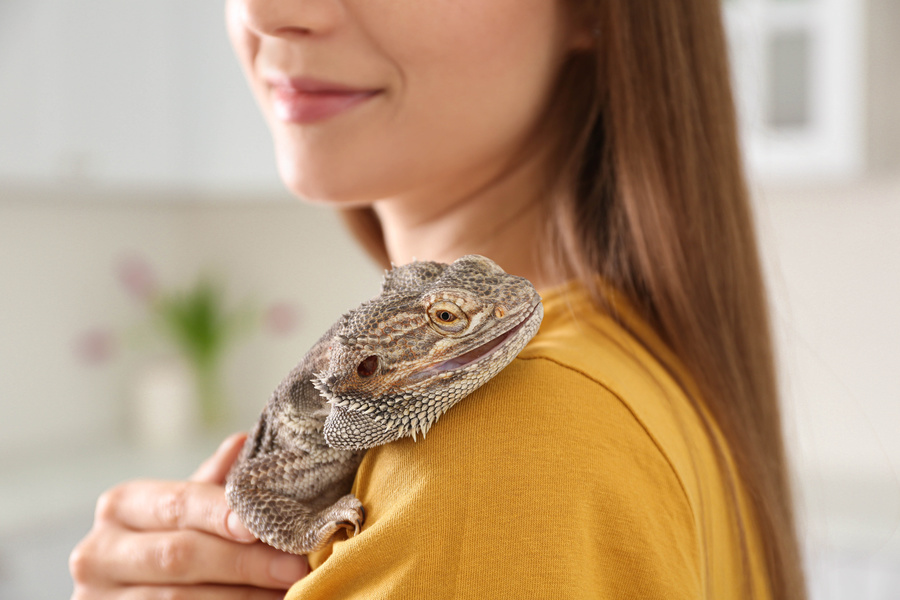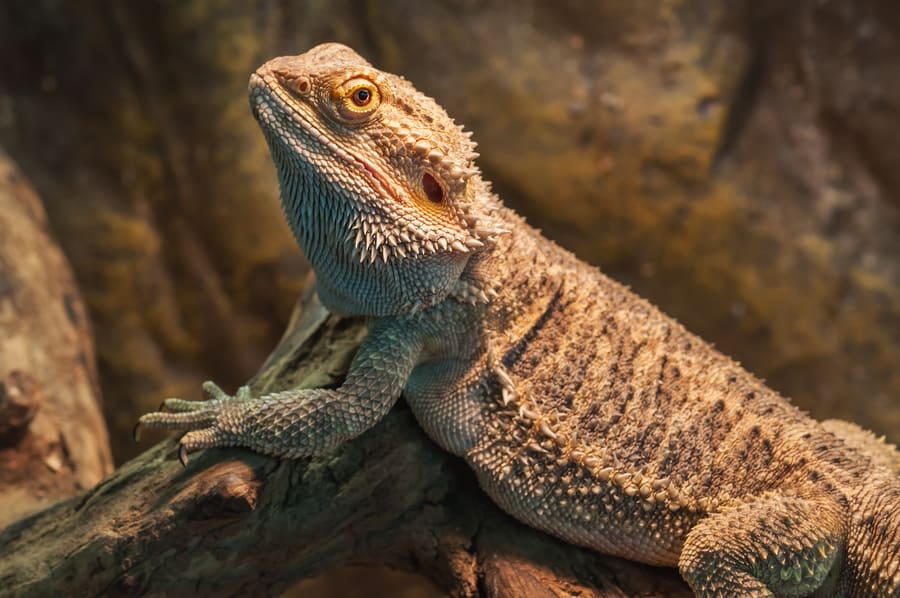
You may have heard that you shouldn’t get a reptile if you want your pet to cuddle, but who’s to say that bearded dragons don’t like physical attention from their owners?
Bearded dragons actually do enjoy attention from their owners. While it will depend on the overall temperament and socialization, many bearded dragons can learn to enjoy being handled and pet.
It may be true that bearded dragons are solitary creatures who don’t necessarily like to share a tank with other beardies (except on rare occasions), but many bearded dragons are quite social. In fact, many do like to have their heads scratched and will enjoy sitting on the couch with you as you watch TV.
Yet, some beardies will tolerate being held more than others. Just like humans, bearded dragons have temperaments and personalities. That being said, some may like the attention of their owners, and others may simply tolerate it.
What it comes down to is socialization and the level of trust that you establish with your bearded dragon. If you spend more time socializing your beardie (more on this later), your bearded dragon will tolerate holding much more.
Expert Insight: According to Rick with Aquatic Pets & Reptiles in Clovis, CA, bearded dragons tolerate being held and pet better than most other lizards. They are very chill when handled for short durations of time. He recommended no more than an hour or 2 per day. If your beardie is getting agitated, its neck may start to turn black and its neck scales may frill out. This is a good sign they are ready to be put down and be left alone.
How Do Bearded Dragons Handle Being Held?
How well your bearded dragon likes to be held will depend on a few factors:
- The age of your beardie.
- How well your beardie is socialized.
- How often you hold your beardie.
- Your beardie’s temperament.
For the most part, your beardie’s tolerance for being handled will come from a mixture of the above factors. We will touch on each of these factors throughout this article, but we will start with a discussion of age.
Baby Bearded Dragons: Being Held
Baby bearded dragons are at the most impressionable age, so they will tolerate the most handling by a new owner. In fact, it is incredibly important to handle your baby bearded dragon every day so that it continues to enjoy human interaction. By handling your baby beardie by holding it correctly, you’ll establish a trusting relationship early on that will carry on into adulthood.
Juvenile Bearded Dragons: Being Held
Juvenile beardies (6 months to 12 months old), like baby bearded dragons, are still at an impressionable age. They are still young enough to create a bond with their owner, and they are still growing and exploring their world. Ideally, you will get your juvenile beardie from a breeder who has handled it often, but if you get your beardie from a larger pet store, it may not have had as much handling.
When you first approach a juvenile—especially an older juvenile—watch for signs of stress and move slowly. After all, you are like a giant to the small reptile, and you don’t want to scare it. Like with all first interactions, start by gently stroking your beardie’s head and give it treats. Luckily, you will likely find that juvenile beardies do tolerate handling well.
Adult Bearded Dragons: Being Held
There are a couple of scenarios you may run into with adult bearded dragons. If you have had your bearded dragon since it was a baby and have interacted with it regularly, odds are your bearded dragon will handle being held. Further, it may even enjoy its time with you and be the couch-cuddling bearded dragon that we all dream of.
But if you adopt an adult bearded dragon from a previous owner, there is no guarantee that it will take to holding right away. Despite what the previous owner has to say about their relationship with their beardie, you don’t know how often the bearded dragon was handled or how it was treated.
If your adopted bearded dragon did not get daily human interaction, you will need to slowly introduce it to handling so that you can build a trusting relationship. Keep in mind that it may take some time for your beardie to trust you enough to be held. So don’t be dismayed if your adult beardie doesn’t like holding right away.
Expert Insight: According to Liz at Kelley’s Pets in Fresno, CA, bearded dragons are like the dogs of the pet reptile world. They acclimate to human contact very well and learn to appreciate human handling and touch.
Proper Handling Guidelines for Bearded Dragons
Regular holding is incredibly important. Simply, the more often you hold and interact with your bearded dragon, the more they will get used to holding and the more likely they will enjoy being held.
Ideally, you should hold your bearded dragon—or at least interact with it—every day. Although you may not have time for an hour-long cuddle session with your beardie, you can still provide that much needed interaction. Even just a few minutes each day makes a world of difference.
How Long Should You Hold a Bearded Dragon?
While 10 to 15 minutes of holding and interacting each day is recommended, even holding your bearded dragon for a few minutes each day can help with socialization. For example, you could make time for holding every time you feed your bearded dragon. You can pick it up, scratch its head, or lightly pet your beardie for that crucial interaction.
When you are interacting with your bearded dragon, you should always watch for signs of stress or discomfort. For bearded dragons that are not used to being held, they may tolerate less interaction than bearded dragons who are held every day. So, you should always watch your beardie’s body language to make sure they are enjoying the cuddle session as much as you are.
Generally, your holding or interacting sessions should not go for more than 1 or 2 hours. More often than not, your beardie will let you know that cuddle time is over because it will start to wiggle.
While it is perfectly acceptable to let your beardie roam around while outside of their enclosure, you do want to make sure that they are returned to their tank. Remember, bearded dragons are cold-blooded, meaning they rely on the external temperature to regulate their body heat. For that reason, too much time spent in a room that is too hot or cold can be dangerous.

How to Hold a Bearded Dragon
Before you hold your bearded dragon, make sure you make your environment calm by turning off any loud television or music. You should also make sure that you are in a comfortable position and that the surrounding environment is safe for your beardie. Once your environment is set, you can hold your bearded dragon.
The best way to pick up your bearded dragon is to get your hands under its body and lift it up slowly (step-by-step instructions can be found below). You want to make sure you support your bearded dragon so that it doesn’t move around too much or wiggle out of your grasp.
When you have your bearded dragon in your hands, don’t squeeze too hard but keep a firm, protective grasp on its body. While you can stand and hold your beardie, we recommend finding a comfortable place to sit so that your bearded dragon can get comfortable.
Once you sit down, you can set your bearded dragon in your lap and let it explore. The beardie might move around your body and find a comfortable place to sit, and once it does, you can lightly pet your beardie.
How to Pick Up a Bearded Dragon
Before you hold your bearded dragon, you should know how to pick it up properly. For safe and easy pick up, we’ve outlined step-by-step instructions:
- Approach your bearded dragon from the side or the front; you never want to surprise your bearded dragon pick it up from above, otherwise, you might scare it.
- Slide one hand underneath your bearded dragon from its side and support its chest and front legs.
- Use your other hand to slide under its back legs and tail. You always want to use two hands so that your bearded dragon is properly supported. Otherwise, your bearded dragon may accidentally wiggle free.
- Slowly lift your bearded dragon out of its enclosure and bring it close to your body.
- Remember not to squeeze, but hold your beardie firmly.
How You Should Support Your Bearded Dragon
When you are holding your bearded dragon, you always want to support all of its legs. You can do this by placing your palm or fingers around your beardie as you lift it up. If you are to hold an adult beardie that is longer, you may also want to support its tail so that it doesn’t wiggle around or jump out of your hands.
Most importantly, you need to be gentle while you hold your bearded dragon. You don’t want to squeeze it or hold it too tightly. Yet, you want to have a firm enough grip so that your beardie doesn’t squirm and fall to the ground.
Signs Bearded Dragon Wants to be Left Alone or Put Down
As a bearded dragon owner, you will get to know your bearded dragon very well. If you understand your bearded dragon’s body language, you can easily recognize when it wants to be left alone or if it wants to be put down. When you’re holding or about to hold your bearded dragon, watch for these signs:
- Stress. Your bearded dragon’s skin darkens.
- Aggression. You hear hissing, see your beardie puff up its beard, or you see your bearded dragon take a defensive stance. If your beardie is trying to bite your fingers, leave it alone and try again later.
- Fear. Your bearded dragon moves away from you when you reach inside the terrarium.
Benefits of Holding Beardies
There are many benefits to holding your bearded dragon. Of course the most obvious is that you will train a beardie to cuddle with you as a dog or cat would, but there are numerous other benefits, such as:
- Socialization. One of the biggest benefits of holding your bearded dragon is that you will be interacting with your bearded dragon consistently and getting used to being around people. That way, when your friends and family come to visit and want to pet or hold your bearded dragon, it will be more likely to tolerate the extra people.
- Easier tank maintenance. Another perk of constant holding and socializing is that you will have a much easier time taking your bearded dragon out of its enclosure for cleaning and maintenance. So instead of having to go through the hassle of setting up a second safe enclosure for your beardie to be in while you clean, you can have your partner, roommate, or responsible child hold your beardie while you clean.
- Bath time becomes a breeze. When you interact with your beardie regularly, all aspects of handling become easier. Plus, your bearded dragon will likely tolerate bath time and regular cleaning much more if it is held consistently and correctly.
- Catch health concerns early. If you hold and handle your bearded dragon often, you will notice any health concerns, such as a stuck shed, distended bellies, or physical injuries, much quicker than if you don’t. Further, treating your bearded dragon will become easier if it is handled consistently because it will be used to being touched.
Training Beardie to Accept Holding
Whether you have a baby beardie or an adopted adult, you should spend time training your bearded dragon to accept holding. First and foremost, you should never dive right in and snatch your beardie from its enclosure. If you do this, you’ll likely scare it. Instead, follow the below steps to help ease your dragon into holding:
- Step 1: Pick a time that works best for holding and make it consistent. Feeding time or daily tank cleaning are both excellent options.
- Step 2: Start with just a few minutes of handling. You don’t want to overwhelm your beardie, so you can start with just 5 minutes and work your way up from there. If you notice that your bearded dragon is not stressed, you can increase the time.
- Step 3: Use treats as a reward. You should find the treats that your bearded dragon likes the best and use those treats, such as mealworms when you handle and hold them.
- Step 4: Start with petting your bearded dragon from the top of its head to its tail. Use just one or two fingers to start, and make sure you pet it lightly.
- Step 5: Gently lift your bearded dragon out of its enclosure. Make sure you support its entire body. When you have it out of its tank, you should sit down in a chair so that you can easily support your dragon. You should only start with a few minutes (2 to 3 to start if your bearded dragon doesn’t take to it quickly), but you can build your time up from there.
Once your bearded dragon learns to trust you, you can start to let your dragon sit on other parts of your body, such as your lap or shoulder. While it depends on the bearded dragon, many do learn to snuggle with their owners.
Additionally, many beardies do love snuggling in a warm, comfortable place such as in your elbow or around your neck. In fact, some beardies love it so much that they will fall asleep while on their owner’s lap. You really can’t get much cuter than that!
Handling Tolerance for Beardies vs. Other Pet Lizards
For the most part, bearded dragons have easy-going temperaments that make them easy to handle. Unlike some pet lizards that just tolerate handling, many beardies will come to enjoy it. Yet, it really depends on the temperament of the individual lizard. While bearded dragons as a whole do like to be handled and held, it’s not unheard of for some beardies to prefer solitude.
For a complete breakdown of how reptiles bond with their owners, please check out this helpful guide.
